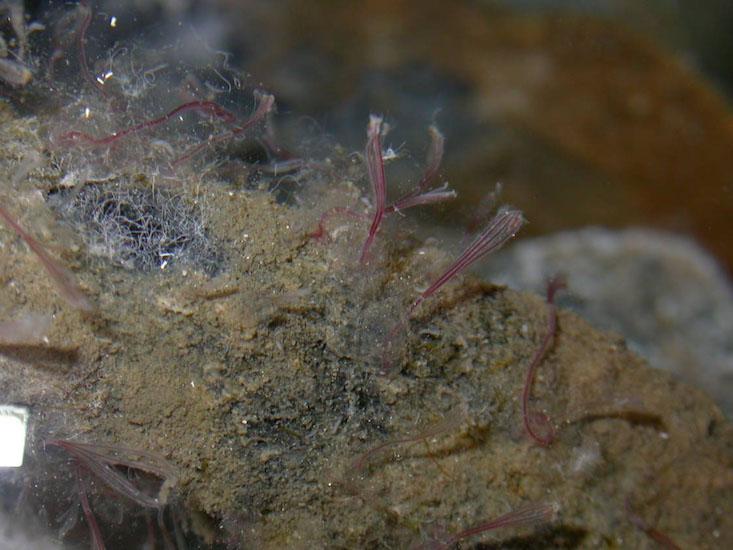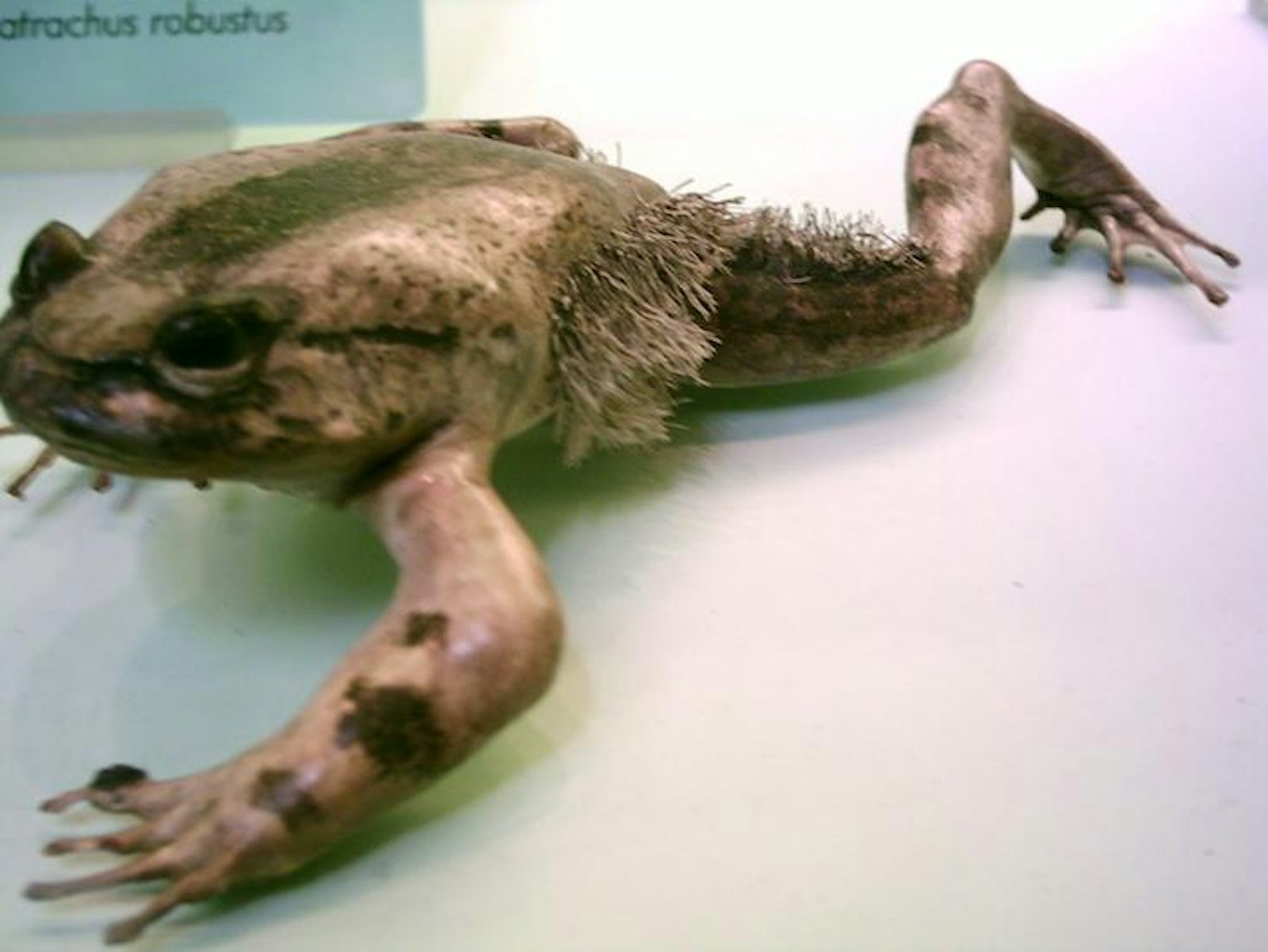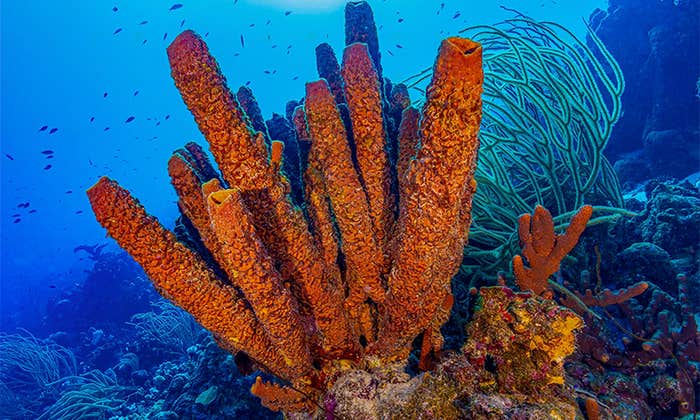Suicide-bombing ants. Bone-breaking frogs. Spit-flinging arachnids. Back-birthing toads. And bone-dissolving worms. What do all of the above have in common? Specialized adaptations. They’ve become so accustomed to their distinct habitats that they’d be more likely to perish, compared to their more generalist relatives, if moved to a slightly different locale.
Each of them, as a result, make the variety of beak sizes among Darwin’s famous finches seem mundane by comparison. That’s because each of these five species below illustrates the seemingly eccentric paths evolution can take groups of organisms on—they’ve become, with time and struggle, distinctive offshoots of their less-specialized ancestors.
1. The Surinam Toad (Pipa pipa)
The Surinam Toad has an eccentric approach to parenting compared to most amphibians, which lay their eggs in water, later to hatch as tadpoles. In South America, female Surinam toads are attracted to males who produce clicking sounds underwater, causing females to release between 60 and 100 eggs. After the male fertilizes them, he ushers the eggs onto the female’s back. The mother’s skin grows over the eggs in a matter of days, providing a safe place for her offspring to develop.
After three or four months, the young Surinam toadlets break free, emerging from holes in their mother’s back fully formed and ready to move and eat on their own. Sometimes they ruthlessly consume their own siblings. The skin, or epithelium, on the mother toad’s back regenerates, and remains intact until the next mating season. Developing frog eggs and tadpoles alike are vulnerable to a variety of predators; the Surinam toad’s child-rearing adaptation increases the chance that more babies will survive each mating season.
2. The Wolverine Frog (Triobatrachus robustus)

Native to Cameroon, Africa, the Wolverine Frog boasts an uncommon adaptation for living amphibians: claws. Scientist David C. Blackburn and his team released a study on the frog in 2008, explaining that these claws are unique due to their lack of keratinous covering. It was initially believed that these talons existed purely to provide a better grip for the frogs as they were about to leap, but Blackburn postulated that they were actually for defense, as they had the capacity to create deep punctures. Cameroonians hunt the frog using machetes and spears to not get injured handling them directly. These claws emerge from the frog’s extremities by breaking through their ventral skin, resulting in a “traumatic wound in which the skin is torn.” It’s still unknown whether or not the original connection between the bony nodule and terminal phalanx regenerates once the claws are retracted.
3. The Malaysian Exploding Ant (Camponotus saundersi)

Though it is no larger than any other ant species, the Malaysian Exploding Ant has poisonous sacs that line its insides from its rear all the way to its head—an extra weapon in defending its colony and, more importantly, its queen. When it sees a potential threat or predator, the ant immediately begins contracting its entire body, causing the toxin within to boil inside of it. Then the ant erupts, covering its opponent in poison that often proves fatal but also functions as a deterrent if a predator does not die from exposure. This power comes at a price: The kamikaze ant dies in the process, “giving its life and limbs for the greater good of the ant colony.”
4. The Zombie Worm (Osedax mucofloris)

The Zombie Worm, also known as the “Osedax” worm—which means bone-eating in Latin—was first discovered on the deep sea floor in 2002, living within a deceased gray whale’s rotting carcass, according to the Smithsonian Institute. This tiny worm flutters about with a set of feathery, plume-like extremities and tentacle-like “roots” 1-3 inches long, and live without a mouth or stomach. Instead, they secrete a bone-dissolving acid through their skin that releases protein and fat trapped inside bones. They digest the fat and proteins with the help of symbiotic bacteria living inside them. The Zombie Worm is anything but a picky eater—not only have colonies been known to populate whale skeletons, but they have also been found on discarded cow carcasses as well as fish bones, also found in the ocean.
The ability to dissolve bones must come in handy when there is not much to prey on besides carcasses. The mechanism by which the zombie worm receives nutrition is unknown, however it is speculated that there is either a transferal of nutrients directly to the worm from the bacteria, or they may digest the bacteria themselves. These bacteria are found in the worm’s “roots,” which are used to drill into and latch onto bones the worms seek to dissolve, while the worm’s plumes function as gills that remove and absorb oxygen from the water around them. These gills can be retracted into the worm’s body when it feels threatened.
5. The Spitting Spider (Scydotes thoracica)

These spiders, native to the United States and Canada, produce a special type of venom—a sticky, silky glue—that it spits onto its prey. The latter part of its name, “thoracica,” is fitting since its dome-shaped thoracic region is morphologically ideal for housing the spider’s venom glands, which are enlarged compared to those found in other spiders. Interestingly, the sticky silk and glue in the venom only mix together once the spider spits at its prey; the ingredients are manufactured separately in distinct parts of their glands.
Much like the Zombie Worm, the spitting spider is not a picky eater, and will consume any insect—even other spiders—it can capture. When hunting, the spider stalks its prey until it is within 10-15 millimeters of it, then spits. Before beginning to eat, the spider waits for a few moments. Once it’s sure its prey is immobilized, it dines.
Sheherzad Preisler is an editorial intern at Nautilus.


























